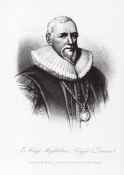History of Bowes Park
Bowes Park is named after Bowes Manor. The first documented mention of the Manor is in a deed of 1397. The Manor grounds covered about 33 acres in the ‘ladder’ area between Palmerston Road and Wood Green High Road, and included a farm adjacent to the current Bowes Road. The Manor was situated between what are now Kelvin and Melbourne Roads. There was a lake – part of the one time course of the ‘New River’ where Belsize Road now lies. An avenue of elms stood along what is now Sidney Avenue, and the gateway arch to the Manor grounds was situated roughly where 15 Sidney Avenue stands now. In 1800 the area was still very rural.
In 1850 the then resident of the Manor, Sir Thomas Wilde, was created Baron Truro of Bowes. He died in 1855, and the estate was purchased by Alderman Sidney, a successful tea merchant, and an Alderman of the City of London for 36 years (and Lord Mayor in 1853-4). He was also Whig and Liberal MP (for Stafford) for separate spells. Hence the plethora of Whig politicians in local street names – for example, Russell, Grenville, Palmerston, Melbourne, Spencer and Kelvin.
The map below shows how the area was laid out in 1844.
Sidney developed the western border of the estate laying out Palmerston Road in about 1870. Previously it had been a tree lined private road with a gateway at either end. Sidney built 13 large houses backing onto the New River, between Whittington and Bowes Roads. Some survive, including no 131 (owned by the Christian Science Society). When Sidney died in 1889, he was buried in front of St Michael-at-Bowes, now under the floor of the new church. After his death, Bowes Manor and its estate were leased to the Guardians of the poor of St Mary’s, Islington, and became run down. The estate and farm were divided up for development in 1899. Sidney, Melbourne, Kelvin, Belsize and Spencer Avenues were laid out, east to west, across the grounds.
In 1843, Bowes Manor Farm sold off a southern part of its domain – to the east of Bounds Green Road. This eventually became the Myddleton Road area. But the transformation awaited the new GNR branch railway from the main line at what is now Alexandra Palace station to Enfield – opened in 1871. This triggered development in the area between the railway line, Bowes Road, Wood Green High Road and Clarence Road. This in turn gave rise to the addition of Bowes Park station to the line in 1880. It took several years of pressure from Alderman Sidney and others before the GNR set aside £3,805 for construction of the station. (GNR’s original plan was for a station immediately by Bounds Green Road; and it was a last minute decision to call the station Bowes Park, instead of Bounds Green). Also in 1880, part of the emerging Bowes Park estate was offered up for auction to ‘persons seeking rural and salubrious residences’ – the High Road, Lascotts, Myddleton, Marquis and Parkhurst Roads. Encouraged by the national Liberal Land Company, development was extended to include Whittington, Palmerston and Sidney Roads. By 1893, the development of Bowes Park extended to the west of the railway to include Brownlow Road. Records at Bruce Castle suggest that Manor Road (between Whittington and Palmerston Roads) was the final development, in 1900 (with number 11 the last to be occupied).
Sir Hugh Myddelton
Myddleton Road was named after Sir Hugh Myddelton who completed the New River in 1609 to bring drinking water into London. In 1858 the watercourse was shortened to bring the New River through what became Bowes Park. There is a listed 19th century tunnel entrance adjacent to Myddleton Road.
In 1920, chronicler Thomas Burke said ‘Bowes Park is Wood Green with its Sunday clothes on’. Restrictive temperance covenants prevented the building of public houses in the area. Religious life was not neglected. Alderman Sidney gave the land (at the junction of Whittington and Palmerston Roads) for the new parish church of St Michaels at Bowes, which was completed in 1874. A modern church replaced it in 1988. In 1901 a Wesleyan Methodist Chapel, St George’s Hall, was opened in Russell Road. A Wesleyan Methodist Church was opened in 1907 on the corner of Bowes and Palmerston Roads. The chapel was vacated, although it remains in use. A new church was completed on the same Palmerston/Bowes Road site in 1973.
Bowes Park was part of the new Wood Green Urban District Council, separated from the Parish of Tottenham in 1888. The borough (as it later became) of Wood Green was absorbed into the new London Borough of Haringey in 1973.
Access to Bowes Park was extended with the opening of Bounds Green Station on the new extension of the Piccadilly line in 1933.
In the 1930s, Bowes Park had its own ‘Bowes Park Weekly News’. In some degree this was a forerunner of this website and the present day newsletter of the Bowes Park Community Association.



